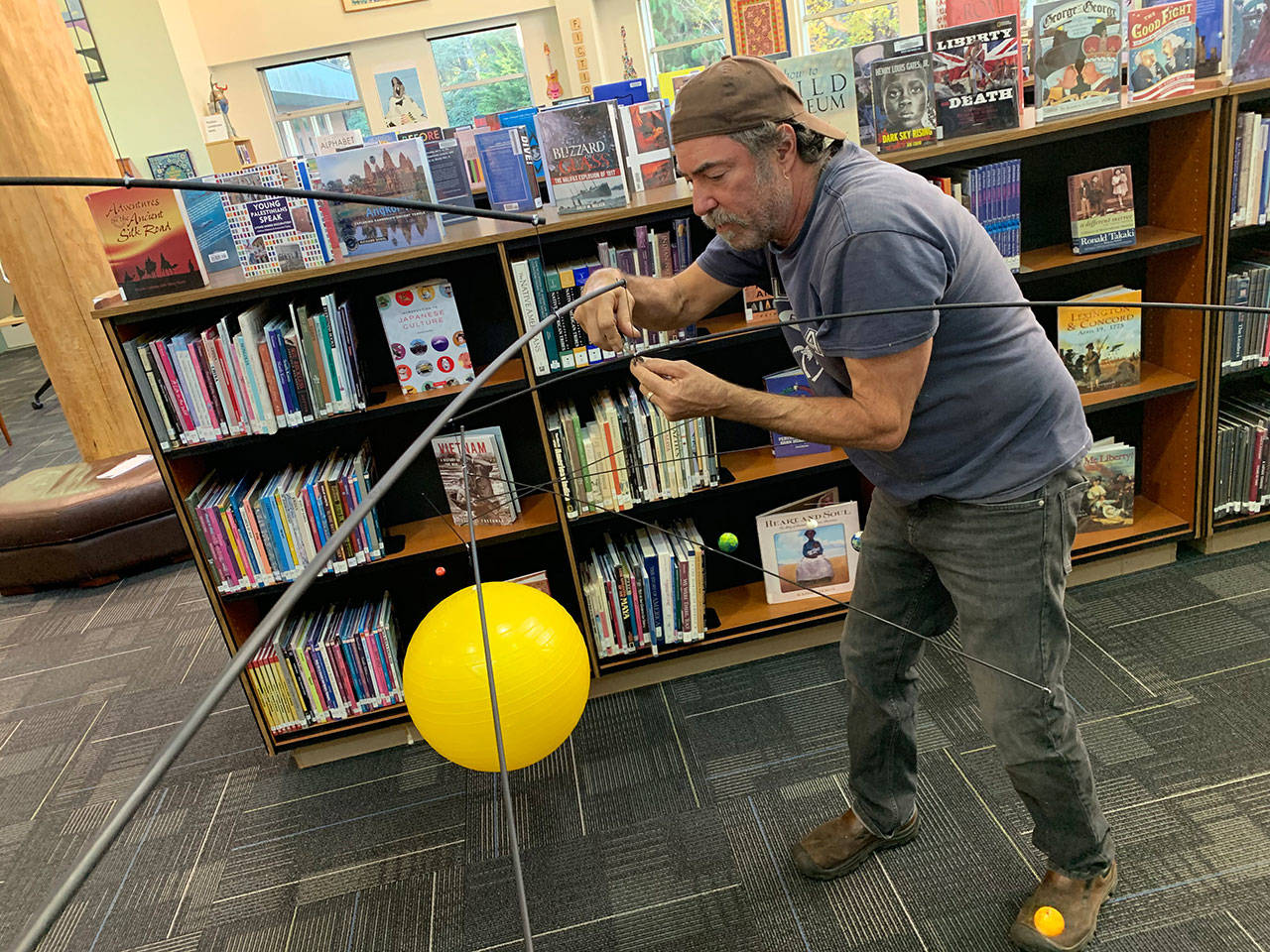After he finished balancing out a mobile of the solar system he had hung in the McMurray Middle School library, island resident Scott Durkee climbed down his ladder, stood back and marveled at what he had just done with the school’s librarian.
“Wow!” he said, watching as the mobile’s planets and sun, hanging from thin strings and light aluminum rods, gently swayed from the library’s high ceiling, where the project was placed.
But Durkee can’t be credited with merely installing the mobile — he made it himself.
“I like it a lot, I think it’s awesome,” he told The Beachcomber, noting the art project is about 17 feet. “It’s the biggest mobile I’ve made or installed anywhere.”
Durkee, whose father was an artist, started making mobiles when he was 13. The first one he made was from cut out beer can logos hanging from wire and strings.
“It was super tacky,” Durkee said. “But since then, I’ve made a lot of them and given them to friends as gifts. I’ve got a bunch at my house right now.”
The McMurray Middle School mobile is not even Durkee’s first one related to the solar system. In the 1990s, he had one hung in the children’s section of the King County Library. But when the library installed a new security system a few years later, the mobile ended up tripping it.
“They figured out what it was, finally. So they had to take it down,” Durkee said. “I said, ‘What am I going to do with it? Well, let me try the library at the middle school because it has a higher ceiling.’”
Durkee’s first solar system mobile hung at McMurray for several years and then “something happened to it.”
“Maybe someone threw something at it and it just went away,” he said. “Every couple of years, I come and check it out and see if it was here. … Julie (Jaffe) was the librarian and I said, ‘Well, I can make another one.’”
At that time, Durfee had hung mobiles at Vashon Center for the Arts and it inspired him to do more of them, so he asked Jaffe if he could make one of the solar system — and she agreed.
“I’m excited to have it there,” Jaffe said. “I like to treat the library as a gallery space, so I like having any kind of art … that piques student interest.”
Jaffe believes the mobile will spark questions for students, not only about the solar system but about who created this piece of art and what materials were used.
She said the solar system mobile will also teach students about problem-solving.
“Scott had to problem solve,” Jaffe said. “As a result, it gets them (students) to think that all projects are problem-solving.”
Durfee painted the planets himself and found the sun — a yellow yoga ball. It took several hours for him to assemble it together to make it a mobile.
“I just want to make sure (people know) this is a representation and absolutely not to scale,” Durkee said.
It took a little longer than he wanted for the school to hang it. He needed a big enough latter to be able to hang the art project from the library’s high ceiling.
“It’s a big job to get a latter in here and all that. It’s probably been almost two months of waiting,” Durfee said. “I’ve been anticipating and, ‘Wow! We did it! We finally did it — and it works.’”
The person who fuels Durkee’s inspiration is Alexander Calder, an American sculptor who was known for creating mobiles, some of which still hang today at prestigious museums like the Guggenheim in New York and the National Gallery of Art in Washington, D.C.
“Alexander Calder is my hero,” Durkee said. “He’s just incredible.”
He said he doesn’t make mobiles like Calder’s, but what attracts Durkee to such works of art is the motion.
“It’s moving art,” Durkee said. “You hang a painting on the wall and it’s beautiful, but it stays on the wall. You hang a mobile and it never stops moving. It’s even better when a fan turns on in the room or a heater turns on and it starts blowing air around. Even the gentlest breeze will move these planets.”
“What’s kind of cool is, that’s the same truth in the real solar system,” Durfee said. “Neptune is always moving; Mars is always moving. Just like in the real solar system, my Mars moves around the Earth faster than my Neptune because it’s a shorter radius.”
“It just seems more dynamic,” Durkee said. “Maybe there’s a reason to look at it for a longer period because you don’t know what’s going to happen next.”
While Durkee is finished with this project, he is hopeful that it will provide some inspiration to the students who use the library.
“I wouldn’t be surprised if books related to planets and solar systems started getting checked out more frequently — why wouldn’t they? That happens,” Durkee said, “and I wouldn’t be surprised if some kid, in some class, some year, ends up being an astronomer … maybe this is the final little nudge he needed, or she.”



